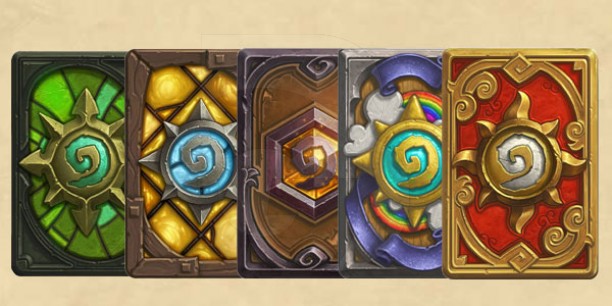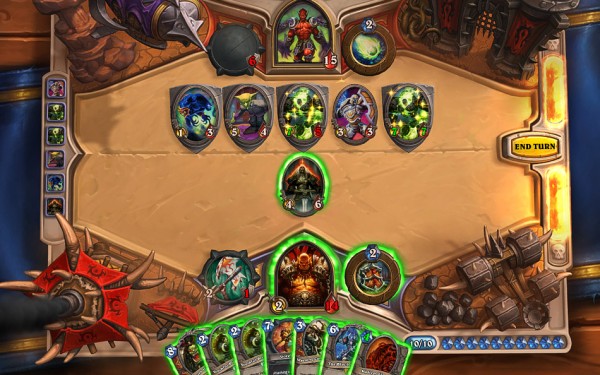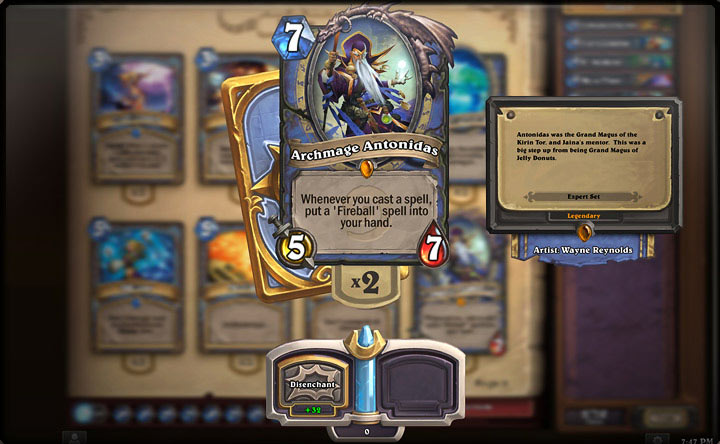If you’ve gotten this far, than you and I have at least one thing in common: we think Hearthstone: Heroes of Warcraft is pretty rad. But maybe you’ve given it a couple games and things just aren’t working out. Or maybe things aren’t so grim, and you’re just looking for advice to break into the next level. Allow me to help. I’ve been playing Hearthstone since early beta, and I admit I am not a professional (I commonly stall out around rank 16-14 each season), but I think I have been playing long enough to have advice worth heeding.
Keep Card Synergy At the Forefront
You only have 30 cards in your deck at a time, so it’s incredibly important that each one has a place there. Even if a card has a really cool ability, if it can’t somehow support or be supported by your other choices, then it has no place in the deck. Every card in constructed play should further your win condition.
“What’s a win condition?” Glad you asked. Your win condition is how your deck plans to beat someone. Is it by overwhelming you opponent with lots of low cost, low power cards and doing so much damage so fast that it’s hard to recover from? Or is it controlling the board – countering spells and removing minions – until you have the mana to summon your big beefy game ender? Every card you put into your deck should support this idea, those that don’t only take away from your chances of drawing those that do.
Know What Your Card Should Be Worth
At each stop on the mana curve, there will be cards that are well worth the price, and ones that are throwaways. For example, the three mana Magma Rager as a 5/1 seems formidable with its heavy attack, but it doesn’t have charge, so it’s vulnerable for its first turn to removal. It will be a priority target, as it only has a single lowly toughness, meaning anything that can do damage will kill it.
On the flipside, the 3 mana Rogue minion, SI:7 Agent, is a 3/3 with an ability that does damage so long as a card was played before it. Three mana isn’t expensive, and many good Rogue cards are cheap (and even free), so getting this extra ability to trigger won’t be hard. Even if it was removed before it could attack, damage was already done.
A good rule of thumb (taken from my general card game experience) is that card worth should match attack/toughness ratings as a default. If a two mana minion isnt a 2/2, then why will determine its worth. The 3/2 Bloodfen Raptor is a good choice for a two mana card, as it has that extra point in attack. Bluegill Warrior is only a 2/1, but it’s Charge ability guarantees it does its two damage to something before it goes, making it a valid choice as well.
Play Arena!
Every opportunity you have to play Arena, you should, as Arena is great for multiple reasons. At 150 gold, you are guaranteed at least a card pack for entry. The extra 50 gold is that cost to play games with Arena rules. Arenas are blind drafts; you are given a choice of three random heroes, and choose one at a time from sets of three (semi) random cards at a time until you hit 30. All cards are in the random card pool, and Arena is the only time your can include the same card in a deck more than twice.
Arena teaches you how to weigh card worth, when you’re not certain what you’ll be able to choose from. Deck building is 9/10ths of success in Arena, and having a good grasp of the game will help you in the long run. You can only lose three total times before your Arena time is spent, and depending on how many wins you’ve accrued during your stay will determine the extra goodies you win. Sometimes it’s gold, sometimes it’s dust, sometimes it’s extra cards. After three wins, you can pretty much count on making your money back through the worth of the card pack and extra bonus prizes.
Minions Must Die!
A safe general practice in any given game is that when your opponent plays a minion, your priority should be killing it. Minions are the bread and butter of this game. Most of your damage output will come from their attack, and most of your deck’s utility from their abilities. When picking offensive spells, the ones that do damage to just heroes should be avoided in most cases, in favor for damage that can be dealt anywhere. Great spells for wiping the board clean can be found in almost every hero’s personal set.
When using minions to get the job done, make sure you’re always trading favorably. By that I mean, make sure that if a minion is attacking another minion, that the attack will kill it, or assist in the same-turn effort of killing it. Also, make sure that if your minion dies doing so, you used a minion less valuable than the one you killed. Generally speaking, using a the mana minion to kill a five mana minion would be a favorable trade. If a minion has a battle cry, and has already used it, then that minion is prime to be sacrificed for a favorable trade, as its worth is now diminished.
Not every minion needs to be killed all the time, though. Sometimes the board will show you in a position of advantage, where you should leave the burden to kill minions on your opponent. For example, you have a 4/3 and your opponent has a measly 2/1. You could kill it and survive, but why waste the opportunity to do 4 damage to the hero right now? Killing the minion will leave your card at a less exciting 4/1, in prime range for really anything to kill it. Should you ignore it, he will have to play another card that will support his 2/1 in the effort to remove your 4/3 next turn, or risk taking another four damage next turn.
Build Your Own Decks
Yes, the Internet is rife with sites where people put up their decklists, ready to be blindly copied until a meta is born (or changed). This isn’t necessarily a bad thing, but it supports the terrible habit of playing with a deck you don’t really understand. Building the deck yourself demands that you know how the cards interact, and reinforces your knowledge of basic gameplay mechanics.
Winning with a deck of your own is also a pretty awesome reward, and a good gauge of just how much know-how you’re retaining in this game. A custom made deck also fits directly into your playstyle. You don’t have to do things you don’t want to do, just to get wins.
Reading up on popular net decks is a smart opportunity for reconnaissance, though. Knowing how these decks work shows you not just the big cards you should be looking out for in ranked matches, but the smaller set up cards/situations that will serve as conspicuous roadsigns for the win condition combo ahead.
Get To Know Your Hero
Your first really important decision is which hero to use. This is an incredibly important decision for two reasons. Firstly, it dictates which set of 25 hero specific cards are available to you. Secondly, it determines your two mana hero power, something that should always be kept in mind when building a deck.
Character powers can seem like they’re gimmicky and unimportant, but that would be a fatal underestimation of their utility. Druids, for example, turn themselves into a minion with one attack for a turn with their power. Any card that boosts the attack of characters is useful here, because you can attack the same turn you use the power. Suddenly your hero takes matters into his own hands, and can put a very sudden hurting on a target. If he incurs no damage in the process, he keeps the armor!
Watch the Throne
Learning by doing is one thing, but if what you’re doing is wrong, then what are you really learning? Sometimes, the best help comes from watching better players play the game. Twitch makes this incredibly easy, as Hearthstone is one of their featured games, and the site will point you towards the most popular streamers. Some do a pretty good job walking through their thought processes, and can really be a wealth of insight when it comes to the nitty gritty surrounding good minion trades and card synergies.
This isn’t to say that they are all so gracious with their information. Many are playing simply to show off their skills, and will snap fire decisions faster than you can understand why. This can also be a tool of learning, if not one that is just a bit less intuitive. Watch their hands, and how long they keep certain cards. Sometimes cards you thought were burning a hole in your hands may require more conservative play. Watch their mistakes, too! Especially if and how they recover.








